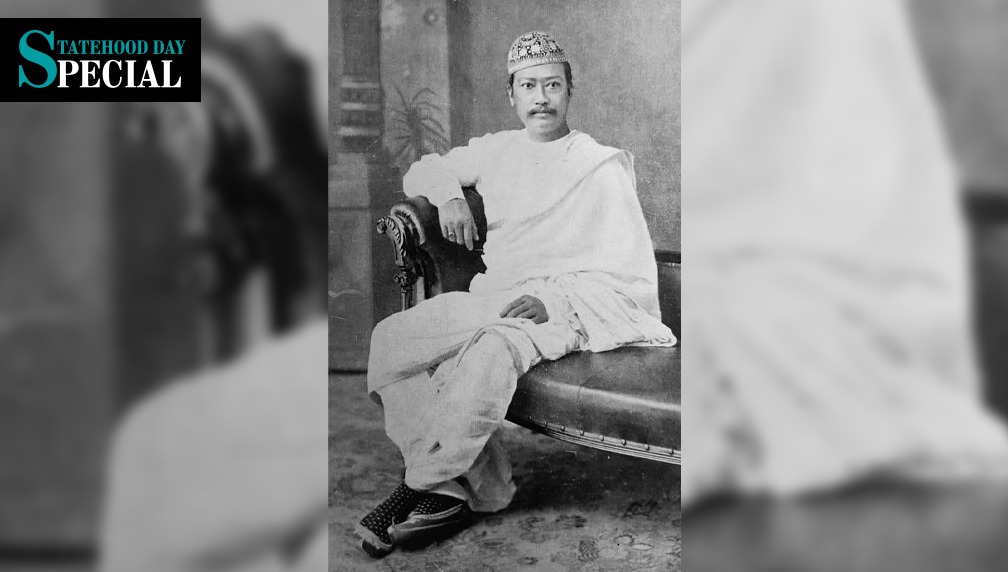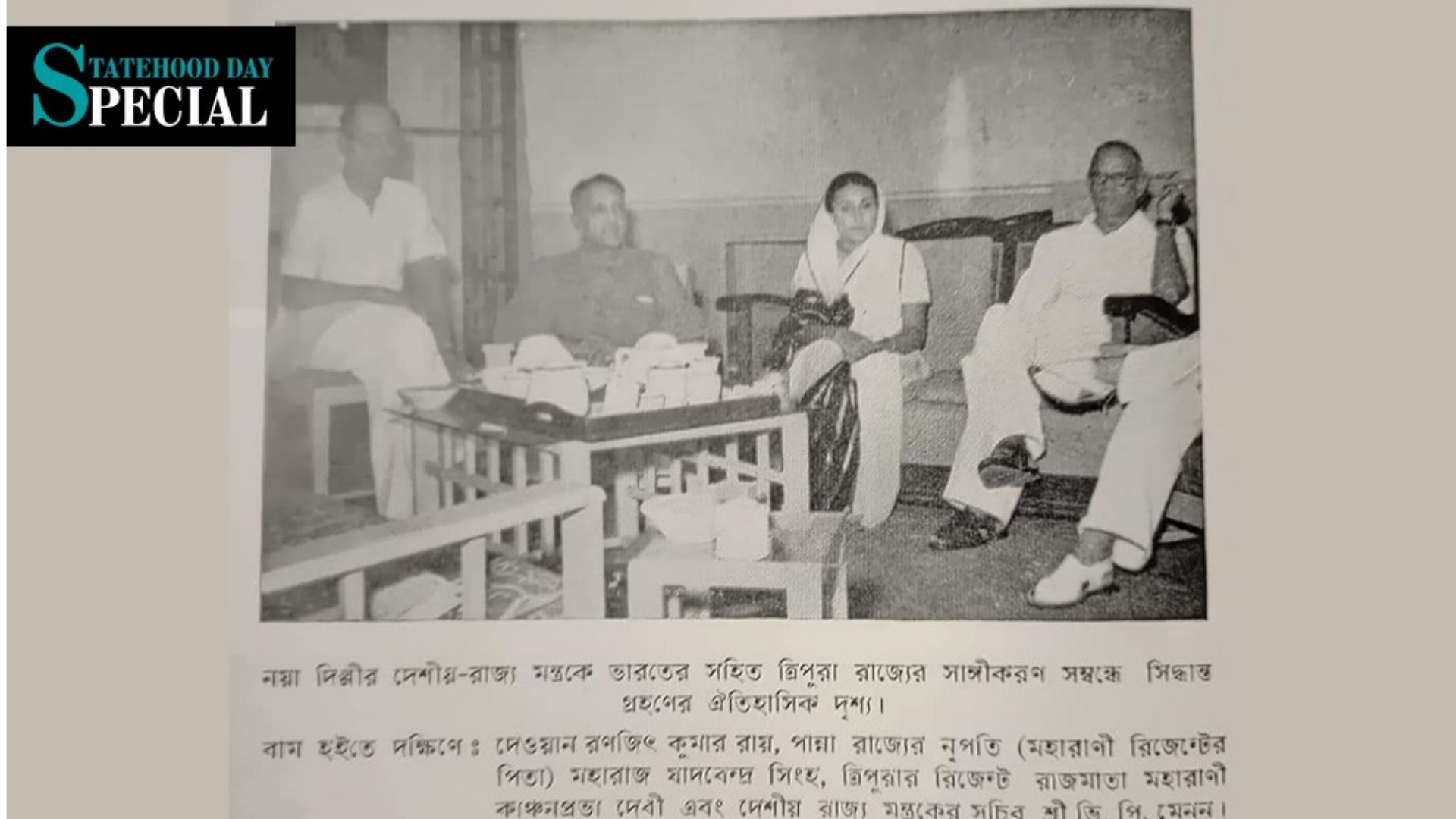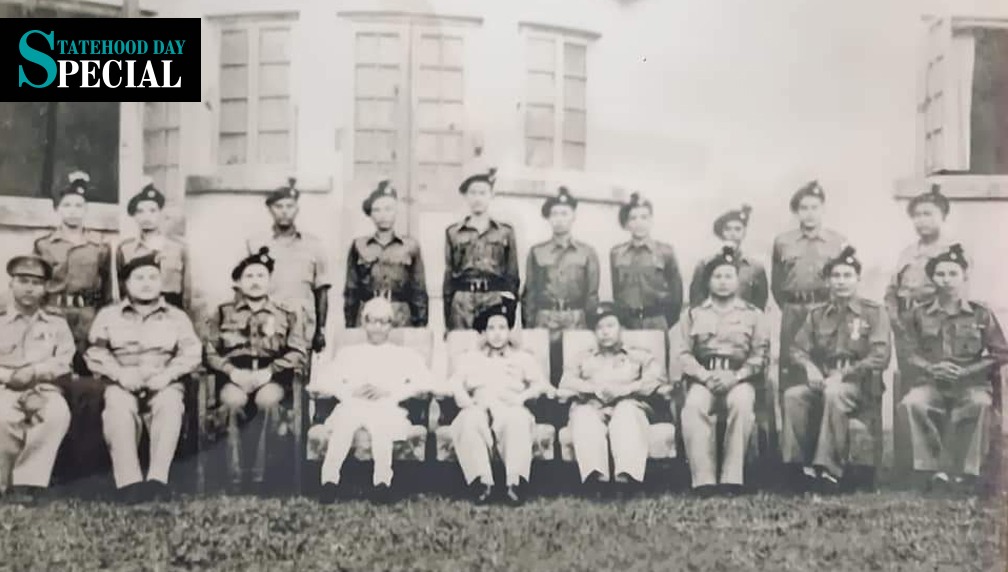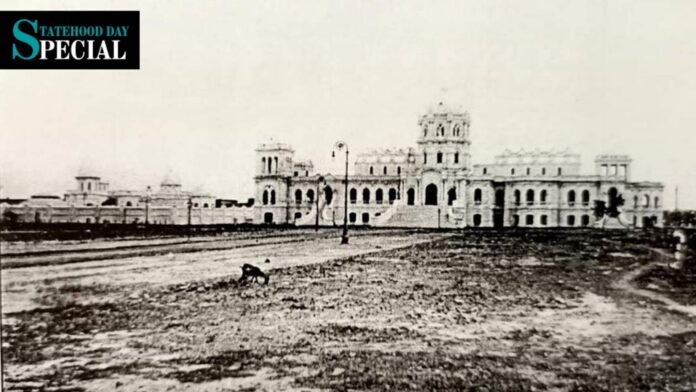By Shekhar Dutta
Any commemoration or celebration of an occasion invariably sparks nostalgic effusion from participants, and witnesses of the event. “It was bliss to be alive on that day and to be a participant in the celebrations was sheer ecstasy” poetized veteran intellectual and journalist Bikach Chowdhury, former press officer to then chief minister Sukhamay Sengupta (1972–1977), now leading a retired life in Calcutta. This year – the third Covid year in succession – Tripura is all set to celebrate the golden jubilee of its full-fledged statehood conferred on 21 January 1972 along with Meghalaya and Manipur. It was a momentous occasion, as the erstwhile princely state, ruled uninterruptedly for close to 550 years by the Manikya dynasty rulers, had made the final transition from an autocratic princely state to a full-fledged democratic polity based on universal adult franchise. This transition was marked by struggles and stress.

Princely Tripura’s last king, Bir Bikram Kishore Manikya (1923–1947), had breathed his last on 17 May 1947 at a time when the entire Indian sub-continent was being ravaged by political storm because of the inevitability of vivisection of the ancient land into India and Pakistan. Before his premature death, Bir Bikram had issued a royal edict on April 28 in state gazette putting on record his decision to merge his domain with the Indian union. There was great instability and disquiet in the entire state over Bir Bikram’s premature death, as the state had passed on to the control of a three-member Regency Council headed by widowed Maharani Kanchan Prava Debi since prince Kirit Bikram Kishore Manikya was a minor. Kanchan Debi signed the instrument of accession on 13 August 1947 and continued ruling the state; the agreement of merger of the state with the Indian union was signed on 9 September 1949. From October 15 that year, Tripura passed under the rule of Centre as a constituent unit, classified as a “C” category state by the constitution that had come into effect on and from 26 January 1950. From then on the state was ruled by a chief commissioner, a high bureaucrat, but the demand for popular representative rule grew strident with movements launched by the Congress as well as the undivided Communist Party of India (CPI). At that time, the state, especially its hill interiors, was being pulverised by a communist insurrection which ended in the year 1952 with the withdrawal of the Central ban order.

This period of turbulence was being underlined by a silent demographic upheaval as riot-stricken Bengalis from erstwhile East Pakistan, mostly from the Tripura kings’ plainland domain in eastern Bengal, the Chakla Roshanabad, had started pouring in the then Hill Tipperah in search of shelter and safety. This change in demography was manifested in relegation of the indigenous tribals to a minority of only 28.44% by the census of 1981, but there was no voice of dissent from the indigenous people. Moreover, Tripura always had a Bengali population – 30% as recorded in the very first British imperial census of 1872 – patronised by the princely rulers who had prioritised the cultivation of plainland for augmenting revenue. In fact, as the influx from riot-ravaged East Bengal had commenced as a trickle in 1941 after the Raipura riots near Dhaka, Bir Bikram had set up reception centres for the newcomers, many of whom were his subjects. But the trickle soon became a tidal wave, altering the delicate demographic equation in the state, sowing the poisoned seeds of discord in the following decades.
The State Reorganisation Commission 1953 constituted by Jawaharlal Nehru had recommended Tripura’s merger with Assam for reasons of economic viability, triggering state-wide protests and a movement. The Centre agreed to upgrade Tripura to the status of a union territory with an elected thirty-member territorial council of limited power with effect from 1 November 1957. It was with effect from 1 July 1963 that the territorial council had been upgraded to a territorial assembly with a five-member council of ministers headed by Sachindra Lal Singha of Congress as the first chief minister. As days passed, the demand for full-fledged statehood intensified with movements launched by the CPI (Marxist) as well as Congress. Faced with similar demands from other central territorial units, the then Prime Minister Indira Gandhi passed the Second Reorganisation of Northeast Act in October 1971, upgrading the union territories of Meghalaya, Tripura and Manipur to full-fledged statehood, and making Mizoram and Arunachal Pradesh union territories, with effect from 21 January 1972.
However, the conferment of full-fledged statehood on Tripura had been preceded by a crisis spawned by the liberation war of Bangladesh triggered by the Pakistan army’s crackdown on innocent civilians on the eerie night of 26 March 1971 under Operation Searchlight and the genocide in its wake. More than 15 lakh terror-stricken evacuees from the then East Pakistan had taken shelter in camps of Tripura at a time when the state’s population was an equivalent number. Contrary to popular perception and belief, the Bangladesh liberation war had not significantly exacerbated Tripura’s post-merger problem of influx from East Pakistan. This is borne out by the fact that, barring 1981, all subsequent census enumeration between 1991 and 2011 recorded a positive growth of tribal population in the state – a greater growth than the majority non-tribal population.

The Congress party headed by Sukhamay Sengupta, who had decisively won the election to the sixty-member assembly introduced a more or less oppressive rule marked by frequent invocation of draconian laws such as the Maintenance of Internal Security Act, DIR, Rule-5 and other acts to suppress opposition and government employees. Tripura’s by now familiar ethnic conflict had also started coming to the fore from the time of Sukhamay Sengupta, with the formation of Tripura Upajati Juba Samity (TUJS) earlier in June 1967. After the disastrous emergency, the Congress ministry fell on account of defections and after two successive and short-lived fragile coalitions. Assembly polls were held on 31 December 1977 under president’s rule. It was the left front all the way as the CPI (M)-led alliance had won 56 out of state’s sixty assembly seats. But the most significant development was the TUJS victory in four assembly seats and the formal beginning of an ethnic explosion in the till-then peaceful state, although grounds for this had been quite fertile for this in the post-merger decades.
Tripura’s ethno-centric politics erupted in full fury shortly after the left front headed by Nripen Chakraborty had come to power with the simmering discontent among indigenous tribals finding expression in TUJS’s movement for the Autonomous District Council (ADC) based on Sixth Schedule and Amra Bangali party opposing. The state witnessed the first ethnic riots in May 1979 on a limited scale and the second within a year in June 1980, and the left front constituted the ADC based on the Fifth Schedule in January 1982. But the movement for Sixth Schedule continued, as it required an amendment of the constitution, which was finally effected by the then prime minister Indira Gandhi in August 1984. Consequently, Tripura ADC passed under the Sixth schedule with effect from 1 April 1985. Nripen Chakraborty’s government (1978–1988) had a well-oiled organizational machinery, but the spate of political murders of opposition Congress workers and supporters and the tribal insurgency led by Tripura National Volunteers and its leader Bijay Kumar Hrangkhawal put the left front on the defensive. Finally with central intervention the ethnic polarisation reached a flash point, and the left front narrowly lost the assembly polls of 1988 with a 29–31 margin.
The next phase in the state was a disastrous five-year rule of the Congress–TUJS coalition government. Despite rise in jobs, the inherent instability of the government reflected in removal of Sudhir Ranjan Majumder and appointment of Samir Ranjan Barman (worsened by a police mutiny and state-wide lawyers’ revolt) and undid the coalition. Finally, under president’s rule, the Congress–TUJS exited power in the elections held in April 1993. The next left front government headed by Dasharath Deb as chief minister with a 49–11 majority thrived on the weaknesses of the opposition. The government lost its effectiveness following a paralytic stroke suffered by the Dasharath Deb in December 1995. The insurgency by two All Tripura Tiger Force and National Liberation Front of Tripura was reaching its peak that time.
There was a change of guard in 1998 when Manik Sarkar became the chief minister for four consecutive terms. Largescale development programmes were implemented, law and order restored, and political murders and violence fell. But the nemesis waiting in the wings finally struck an over-confident left front in the run-up to the assembly polls of 2018. After a long twenty-five years of continued left rule, the Bharatiya Janata Party (BJP) won a landslide from a paltry 1.87% votes in 2013 polls. The success of BJP in Northeast convinced the electorate here that the party could unseat the left front. What facilitated the process was the BJP’s so-called Vision Document, released days ahead of the February 2018 polls, making altogether 299 promises. The left front secured only 16 seats, conceding 36 to BJP and 8 to its regional ally, the Indigenous Peoples Front of Tripura. But BJP’s anocracy and action programme based on the “rule of anarchy” may lead the party nowhere in the elections next year.
ALSO READ: https://themeghalayan.com/momentous-journey/


